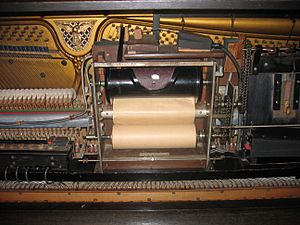Pianola facts for kids
A pianola (say: "pee-ah-NO-la") is also known as a player piano. It's a special kind of piano that can play music all by itself! Imagine a piano where the keys move as if an invisible person is playing. That's a pianola.
It works using air power, which is called a pneumatic system. Early pianolas used foot pedals to pump air. Later ones had electric pumps. Inside, there are paper rolls with tiny holes punched in them. These holes let air through, which makes the piano keys move and play the notes.
Contents
What is a Player Piano?
A player piano looks like a regular piano. But it has a hidden system inside that lets it play music automatically. This system uses air pressure to make the hammers hit the strings. It's like a robot pianist!
How Does a Pianola Work?
The magic of the pianola comes from its special parts.
- Paper Rolls: These are like the "brain" of the pianola. They are long sheets of paper with holes. Each hole tells the piano which note to play.
- Air Power: Air is pumped into the piano. When a hole in the paper roll lines up, air rushes through it.
- Bellows and Pneumatics: This air activates small air bags called "pneumatics." There are 88 of these, one for each piano key. When a pneumatic fills with air, it pushes a lever.
- Playing the Keys: This lever then makes the piano hammer hit the string. This is how the notes are played.
The largest air bags are the foot-operated bellows. Other smaller ones control things like the speed of the roll and the piano's pedals.
History of the Pianola
The pianola was invented around the 1880s. It was a very exciting invention because it let people enjoy complex music at home. Even if someone couldn't play the piano well, they could make it sound amazing!
Rise in Popularity
The pianola became very popular in the late 1800s and early 1900s. This was a time when more and more families bought pianos for their homes. People also bought lots of sheet music. The pianola let everyone enjoy music, even if they weren't expert musicians. Players could also control how the music sounded, like making it louder or softer.
Decline of the Pianola
By the 1920s, the pianola started to lose its popularity. Why? Because the gramophone (an early record player) was invented. Gramophones were easier to use and could play many different kinds of music. People could just listen to music without needing a special piano.
Images for kids
-
Steinway Welte-Mignon reproducing piano (1919)
-
Player and control unit of Yamaha Disklavier Mark III
-
Sequencer control unit of Yamaha Disklavier Mark III
See also
 In Spanish: Pianola para niños
In Spanish: Pianola para niños








